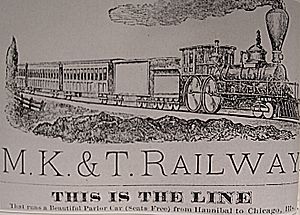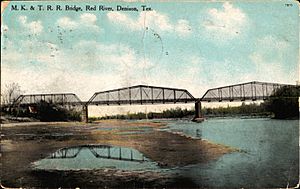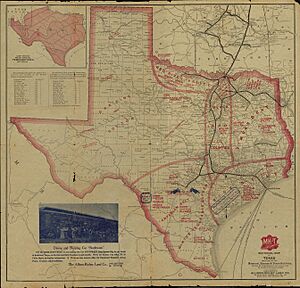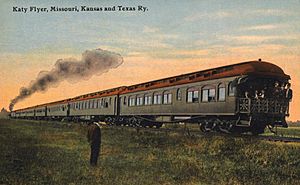Missouri–Kansas–Texas Railroad facts for kids
 |
|

Katy system as of 1918; many of the outlying lines left the system in the 1923 reorganization
|
|
| Overview | |
|---|---|
| Headquarters | Dallas, Texas |
| Reporting mark | MKT |
| Locale | Kansas, Missouri, Oklahoma, and Texas |
| Dates of operation | 1870–1988 |
| Successor | Union Pacific Railroad |
| Technical | |
| Track gauge | 4 ft 8 1⁄2 in (1,435 mm) standard gauge |
The Missouri–Kansas–Texas Railroad, known by its reporting mark (reporting mark MKT), was a major train company in the United States. Its last main office was in Dallas, Texas. Started in 1865, it built a large network of train tracks across Texas, Oklahoma, Kansas, and Missouri. In 1988, it joined with the Missouri Pacific Railroad. Today, it is part of the Union Pacific Railroad.
In the 1890s, people often called the Missouri–Kansas–Texas Railroad "the K-T." This was because it was once a part of the Missouri Pacific Railroad, and "KT" was its short name in train schedules and on the stock market. This soon led to its famous nickname, "the Katy."
The Katy was the first train line to enter Texas from the north. Over time, the Katy's main system connected many important cities. These included:
- Parsons, Emporia, Fort Scott, Junction City, Olathe, and Kansas City, Kansas
- Kansas City, Joplin, Columbia, McKittrick, Jefferson City, and St. Louis, Missouri
- Tulsa, Wagoner, and Oklahoma City, Oklahoma
- Dallas, Fort Worth, Waco, Temple, Austin, San Antonio, Houston, and Galveston, Texas
In the 1980s, another main line was added between Fort Worth and Salina, Kansas. This happened after the Chicago, Rock Island and Pacific Railroad closed down. The Katy also gained access to Lincoln and Omaha, Nebraska, and Council Bluffs, Iowa. By the end of 1970, the Katy operated over 2,623 miles (4,221 km) of track.
Contents
The Katy's Story
How the Katy Started
The Missouri, Kansas & Texas Railway officially started in May 1870 in Junction City, Kansas. The company received special permission to build a train line. This line would connect military forts like Fort Riley, Fort Gibson, and Fort Scott. It also aimed to reach Fort Worth and connect with other train lines. The bigger goal was to link Chicago and New Orleans by rail.
When it was formed, the Katy took over the Union Pacific Railway, Southern Branch, which had started in 1865. This gave the Katy 182 miles (293 km) of track in Kansas. The Katy also joined with other smaller train companies. These new lines became the base for the Katy's growth.
Congress had promised land to the first train company that reached the Kansas border through the Neosho Valley. The Katy was in a race to win this prize. On June 6, 1870, Katy workers laid the first rails across the Kansas border, winning the race. However, the land grants were never given. This was because courts decided the land was in Indian Territory and belonged to Native American tribes.
The Katy kept building south, laying tracks through the territory. It reached Texas in 1872. The company bought other small train lines as it grew. It reached Dallas in 1886, Waco in 1888, Houston in 1893, and San Antonio in 1901.
When the Katy train line reached Houston, it also gained access to the Port of Galveston. This was because the Katy partly owned the Galveston, Houston and Henderson Railroad. This gave the Katy a direct link to ocean shipping on the Gulf of Mexico.
Life on the Katy
On July 14, 1892, a Katy train was robbed by the Dalton Gang in Adair, Oklahoma. This area was then known as Indian Territory. The gang escaped after a gunfight.
In 1896, the Katy was part of a huge publicity event. A man named William Crush arranged for two locomotives to crash head-on. This happened at a place later called Crush, Texas. More than 40,000 people watched the crash. Some people were hurt by flying pieces from the exploding engines. Ragtime musician Scott Joplin was performing nearby at the time. He wrote a piano song called "The Great Crush Collision March" to remember the event. He dedicated it to the Missouri-Kansas-Texas Railway.
| Year | Traffic |
|---|---|
| 1925 | 3317 |
| 1933 | 1827 |
| 1944 | 7256 |
| 1960 | 3980 |
| 1970 | 4999 |
From 1915 until 1959, the Katy ran a famous passenger train called the Texas Special. It ran from St. Louis to Dallas, Fort Worth, and San Antonio. The Katy ran this train with another company, the St. Louis – San Francisco Railway. The train had special cars named after famous Texans, like Sam Houston and Stephen F. Austin.
The city of Parsons, Kansas, was a very important spot for the Katy. It was where main lines crossed, going to St. Louis, Kansas City, and south to Oklahoma. So, Parsons was chosen for the first big train repair shops. Later, other repair shops were built in Sedalia, Missouri, and Denison, Texas. When trains started using diesel engines, most of the repair work moved back to Parsons.
What Happened to the Katy?
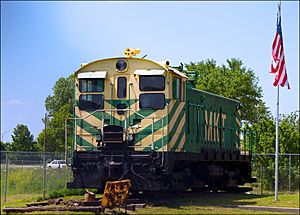
On August 12, 1988, the Missouri Pacific Railroad (MoPac) bought the Katy. The MoPac was owned by the Union Pacific Corporation. During the 1980s, many train companies were joining together. The Katy had been looking for a company to merge with. On December 1, 1989, the Katy officially became part of the MoPac. Today, it is part of the larger Union Pacific Railroad system.
After the Katy lines were no longer used for trains, many parts of its old tracks were turned into trails for walking and biking. This is part of a program called "rails to trails."
- In Missouri, much of the old Katy line is now the Katy Trail State Park. This park runs along the Missouri River.
- In downtown Dallas, a 3.5-mile (5.6 km) section is being turned into the Katy Trail. This trail connects Southern Methodist University to the American Airlines Center.
- In 1997, the section linking Katy, Texas, to downtown Houston was closed. It was later turned into the Heights Bike Trail in 2009.
- In Tulsa, Oklahoma, an 8.1-mile (13.0 km) Katy trail follows an old train path. It goes between downtown Tulsa and its nearby town of Sand Springs.
To honor the Katy, the Union Pacific Railroad painted one of its new locomotives in the traditional Katy colors in 2005. This train is called Union Pacific 1988.
Katy Passenger Trains
The Katy ran several famous passenger trains. These trains often started in St. Louis or Kansas City. They would meet in Parsons, Kansas, then split in Denison, Texas. Some parts went through Dallas, others through Fort Worth. They would then meet again in Waco, Texas, before heading south to San Antonio or Houston.
Here are some of the Katy's named passenger trains:
- The Texas Special (Train numbers 1 and 2): This train ran from St. Louis, Missouri, to San Antonio, Texas, from 1917 to 1959. It later ran from Kansas City to San Antonio, and then Kansas City to Dallas.
- Katy Limited (Train numbers 3 and 4): This train went from Kansas City to Dallas, with parts going to Oklahoma City, Fort Worth, and San Antonio.
- Katy Flyer (Train numbers 5 and 6): These trains started in St. Louis and Kansas City and went south to San Antonio.
- Bluebonnet (Train numbers 7 and 8): This train traveled from Kansas City to San Antonio through Dallas, and from Kansas City to Houston through Fort Worth.
- Sooner (Train numbers 23 and 28): This train ran between Kansas City and Oklahoma City.
Katy Leaders
Here are some of the people who served as presidents of the Missouri–Kansas–Texas Railroad:
- Judge Levi Parsons (before 1878)
- C.Clark (1879)
- Jay Gould (1880)
- George J. Gould (1886–1887)
- Henry C. Rouse (until 1904)
- Frederick N. Finney (1904–1906)
- Adrian H. Joline (1906–)
- Charles E. Schaff (1912–1926)
- Charles N. Whitehead (1926)
- Columbus Haile (1927–1930)
- Michael H. Cahill (1930–1934)
- Matthew S. Sloan (1934–1945)
- Donald V. Fraser (1945–1956)
- William N. Deramus III (1957–1961)
- Charles T. Williams (1961–1965)
- John W. Barriger III (1965–1970)
- Reginald N. Whitman (1970–1975)
- Harold L. Gastler (1975-1988)
Images for kids


